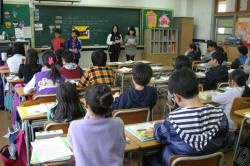Post-method methodology
 |
| a new dawn? |
This is nothing terribly new. Here's a comment from a 1983 publication:
During the sixties and seventies
several developments indicate a shift in language pedagogy away from the
single method concept as the main approach to language teaching.
(Stern, 1983:477)
 |
The sources of dissatisfaction with methodology |
Dissatisfaction with the accepted methodologies had been growing for some time, since well before 1983, because:
- there was a lack of any sound empirical evidence that any method works any better than any other
- the whole concept of method limits teachers and learners and prevents them reaching their true potential
- methods imposed on teachers and learners stifle creativity and autonomy
- there was a noticeable disenchantment with the idea that the application of some kind of scientific method could have the outcomes it promised
- methods ignore the huge range of learners' needs, settings, personalities and cultures
- methods lead to disempowerment of both learners and teachers and contribute to dominance by society's power holders and the deskilling of teachers
Recently, since the mid-1990s at least, the idea of a post-method language teaching has become more widely accepted.
The guide to methodology refined, linked from the methodology index (below), attempts some rebuttal of the criticisms above.
 |
Defining post-methodology |
This is, unfortunately, much more difficult than saying what it
isn't.
The overarching idea is, in Kumaravadivelu's words, the assertion
that:
we cannot prepare teachers to tackle so
many unpredictable needs, wants and situations; we can only help them
develop a capacity to generate varied and situation-specific ideas
within a general framework that makes sense in terms of current
pedagogical and theoretical knowledge.
(1992, p. 41)
Given this umbrella assertion, he then enumerates three guiding principles: particularity, practicality, and possibility.
- particularity
- This refers to the role of the context and setting. The
focus is on local needs, local constraints and local culture.
Kumaravadivelu (2006:171) notes that it is necessary to be
sensitive to a particular group of teachers teaching a particular group of learners pursuing a particular set of goals within a particular institutional context embedded in a particular socio-cultural milieu - practicality
- This refers to relationship between theory and practice.
In the past, the criticism that 'theorists don't teach and teachers
don't read' has been arguably justified so the gap between what is
proposed at the theoretical level and what the teacher understands at
the practical level has grown.
In Kumaravadivelu's words,
Practicality seeks to rupture the reified role relationship between theorizers and practitioners by enabling and encouraging teachers to theorize from their practice and to practice what they theorize.
In other words, it raises the role of the teacher to an action researcher rather than a follower of a methodology laid down by others. - possibility
- This refers to tapping into the socio-political consciousness
that learners bring with them to the process of language learning,
hence raising cultural awareness.
 |
Classroom implications |
Kumaravadivelu proposes ten micro-strategies that are the consequence of adopting a setting-sensitive approach to designing and implementing a language-learning programme.
- Maximise learning opportunities
- Facilitate negotiated interaction
- Minimize perceptual mismatches
- Activate intuitive heuristics (i.e., problem-solving approaches)
- Foster language awareness
- Contextualise linguistic input
- Integrate language skills
- Promote learner autonomy
- Ensure social relevance
- Raise cultural consciousness
None of these, you note, is prescribed in terms of what is done in the classroom because that will, inevitably, be dictated by the setting in which language learning is taking place. The admonition is only that these are the aspects of a teaching programme to aim at.
 |
The end of the line for methodology? |
Not quite.
Methods have their attractions, mostly because they sound rather scientific and ought, therefore, to be backed up with some empirical evidence demonstrating their effectiveness. The key word in that is 'ought'.
A very brief web search will throw up rafts of sites claiming to be the best way to learn a language and many make extravagant claims concerning their effectiveness. Some, for example, promise to teach you mastery of a language in less than three months, some claim to do even better. Others claim that you only need to study for 10 minutes a day to gain mastery of any language you need. The problem with all of them, of course, is they can't produce a scrap of real evidence to back up the claims. This leads some cynics to believe that they are less interested in your success than your money.
On the other hand, methodologies in the classroom are still
recognisable from time to time.
Most obviously, it would not take long in someone's classroom to
recognise that they were adopting a form-based or a function-based
approach to teaching and within those categories, it would not be
difficult to spot a task-based approach, a communicative approach or an
audio-lingual approach.
The problem, of course, is that if you returned to the same classroom at
a different time, you may well arrive at different conclusions
concerning the methodology being adopted.
Why should this be?
 |
Eclecticism |
Eclecticism is an approach that does not hold with applying a single theory or paradigm but attempts to draw on the best (or most appropriate) from a range of competing methodologies. Just as you would expect to find a range of styles and types of objects in a good flea market, so you would expect to find a range of approaches operating in an eclectic classroom.
Whether this is, as some have described it, principled eclecticism is a matter of judgement. The term 'principled' strongly implies that it is based on a single coherent theory of both how languages are learned and what language actually is. As we shall discover, if the theories underlying the approaches implemented conflict then it is difficult to see how what the teacher is doing can be described as principled in approach.
 |
Classroom implications |
Clearly, some form of eclecticism fits well with the ideas of post-methodology because the practitioner can use whatever method comes to hand to achieve the 10 micro-strategies set out above. It might work something like this:
| Micro-strategy | Methodological approach |
| Maximise learning opportunities | If the targets are structural, use a structural approach and so on. Drill when necessary and prioritise learner talk over teacher talk. |
| Facilitate negotiated interaction | Ensure that group- and pair-work are emphasised so use a task-based learning approach or Dogme, for example. |
| Minimise perceptual mismatches | Contextualise everything, avoid focusing solely on usage and deploy a meaning-based approach. Use a lexical approach. |
| Activate intuitive heuristics | Provide opportunities for language analysis and problem-solving activities by using skeleton sentences, gap-filling exercises and task-based lessons. |
| Foster language awareness | Use grammar translation to help learners notice the difference between L1 and L2. Focus on form and the meta-language to describe it. |
| Contextualise linguistic input | Use an Oral / Situational Approach so that all language is clearly set in a context and relationships between users are identifiable. |
| Integrate language skills | Use a task-based approach and ensure that learners can react orally to what they read, write about what they hear and so on. |
| Promote learner autonomy | Use projects and other tasks to take learners out of the classroom and give them the opportunity to research independently. |
| Ensure social relevance | Set language in a clear, local, social context so that it is relevant to learners. Personalise tasks and language input whenever possible. |
| Raise cultural consciousness | Use a conversation-driven approach (e.g., Dogme) to exchange ideas about cultural differences. Set language in its cultural context. |
It's easy to see that taking this kind of approach would provide the classroom with a lot of much-needed variety and be easy to justify in terms of why one is doing the teaching this way. There are downsides, of course, because the theories underlying methodologies are often mutually exclusive:
- If behaviourist theories of language learning are wrong, the drilling and pattern-repetition activities will be a waste of time.
- If behaviourist theories are correct, then time spent on cognitive and problem-solving activities is wasted.
- If a focus on the learners' first language is counterproductive, then any use of it will be harmful and time wasting.
- If adults acquire an additional language in same way that they acquired their first language, then all that is needed is immersion and context to ensure learning. Any focus on structure and pronunciation is simply non-functional.
and so on.
 |
Coursebooks |
All that is necessary to implement a post-methodology, eclectic approach is to follow a well-known coursebook.
A glance at the teacher's book for many of these and at the publisher's descriptions make it clear that no single methodology has been selected. On the contrary, it seems to be a matter of some pride to the authors that they have adopted a range of methodological approaches, regardless of the fact that some of these may be mutually antagonistic.
For example, 'exercises put rules into practice' seems to imply that language is learned by the application of structural rules but the same coursebook claims that the book endeavours to 'develop real-life communication skills'. Now, either language is learnt via the application of rules or it is learned by the pressure of communicative need. You can't really have it both ways.
The authors of one very popular coursebook (Inside Out) claim that:
- it aims to maximise exposure to high frequency language
- Students are ... given opportunities to manipulate the new language and try it out in different situations
- The new language is systematically reviewed and recycled until finally the students feel confident enough to use it to make their own meanings
- they are strong believers in the old adage: ‘practice makes perfect’
What we have here then is:
- a commitment to language exposure (a nod to Krashen, perhaps, to corpus linguistics and to a lexical approach implied by the 'high frequency')
- a commitment to manipulative non-personalised structure practice (an audio-lingual approach)
- a communicative approach to 'making their own meanings'
- a behaviourist approach to practice and repetition instilling good habits and reinforcing learning
In the sample unit available online we find the following eight approaches:
- Test–Teach–Test:
Students are asked to talk to a partner about an experience before they have encountered the language. - Structural Approach [without personalisation]
Students have to complete a gap-fill exercise about people in a text whom they have never met with can or can't to express ability. - Audiolingualism:
A CD-based listen-and-repeat exercise - Task-based Learning
Students carry out a class survey. - More non-personalised structural practice structure:
Students write questions with How many, regardless of whether anyone in the room wants to know the answers. - Audiolingualism:
Learners listen and repeat the names of body parts. - Total Physical Response:
Learners have to touch parts of the body when listening to prompts. - Lexical approach:
Learners practise words with -ache set in sentences with delexicalised verbs.
You can, of course, carry out the same exercise with a range of modern coursebooks and reach similar conclusions. Try it with yours.
If you are preparing to take or have taken the Cambridge Delta, you will be familiar with the fact that one of the tasks in the written examination for Module One requires candidates to play spot-the-methodology from a coursebook extract.
Post-method methodology seems to have arrived. And it's called course-book methodology.
Related guides to methodology are available from
the methodology index.
There are also related guides in
the background index.
References:
Kay, S & Jones, V, n.d., New Inside Out, Macmillan [available
online at: http://www.insideout.net/new/about/course]
Kumaravadivelu, B, 2006, TESOL methods: Changing tracks,
challenging trends, TESOL Quarterly 40(1), 59-81.
Kumaravadivelu, B, 1992, Macrostrategies for the second/foreign
language teacher, Modern Language Journal, 76, 41–49.
Stern, HH, 1983, Fundamental Concepts of Language Teaching,
Oxford: Oxford University Press
